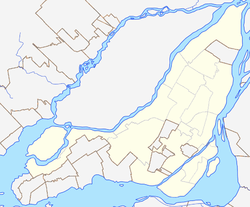Red-Light District, Montreal
| Red-Light District | |
|---|---|
| Neighbourhood | |
| Quartier du Red-Light | |
 Red-Light District Location of the Red-Light District in Montreal | |
| Coordinates: 45°30′36″N 73°33′50″W / 45.509873°N 73.563768°WCoordinates: 45°30′36″N 73°33′50″W / 45.509873°N 73.563768°W | |
| Country | Canada |
| Province | Quebec |
| City | Montreal |
| Borough | Ville-Marie |
The Red-Light District (French: Quartier du Red Light) of Montreal, Quebec, Canada was formerly centered on the intersection of Saint Laurent Boulevard and Saint Catherine Street in the borough of Ville-Marie.
The neighbourhood has historically been home to cabarets and illegal businesses as early as the mid-nineteenth century, but especially between 1925 and early 1960s. The term Red Light recalls the old lantern on the doors of brothels. Gambling, illicit taverns and prostitution have marked the history of this area, also related to Prohibition in the United States and Montreal's status as a port-city. Today, there are still traces of this type of activity, but it is much more discreet.
The variety shows that took place in the neighbourhood launched the careers of several foreign artists and was equally the starting point for many local artists. There still remains some strip clubs and cabarets in the area, such as the Café Cleopatre, threatened with demolition in 2009 by an urban renewal project linked to the nearby Quartier des spectacles. The Montreal Pool Room fast-food restaurant is also located there.
Description

There is no official red-light district, although the definition of the boundaries has varied according to both the source and the time period. According to Viviane Namaste in 1973, it was bordered by René Lévesque Boulevard to the south, Sherbrooke Street to the north, Saint Laurent Boulevard to the west and Saint Denis Street to the east.[1] According to Daniel Proulx, it was defined early in the twentieth century by Sherbrooke Street to the north, Saint-Denis Street to the east, Bleury Street to the west and by Old Montreal to the south. Proulx claims that today, it has shrunk to centre on the corner of Sainte-Catherine and Saint-Laurent, the area's historical heart.[2]
Prostitution, gambling and drinking were more prevalent in this area because of its proximity to the city centre, which is often a major tourist attraction, and the high density of liquor shops (taverns, bars, night clubs, cabarets, etc.).
The red-light district is used as a setting in the Kathy Reichs novel Déjà Dead.
See also
- The End of Pinky, an animated short set in the district
References
- ↑ Namaste, Viviane (2005). C'était du spectacle! L'Histoire des artistes transsexuelles à Montréal: 1955-1985. Studies on the History of Quebec / Études d'histoire du Québec (in French). McGill-Queen's University Press. ISBN 0-7735-2908-X.
- ↑ Proulx, Daniel (1997). Le Red Light de Montréal (in French). VLB éditeur.